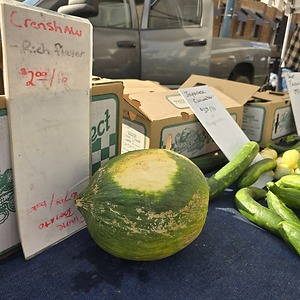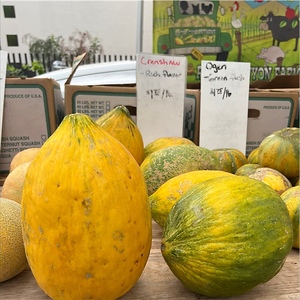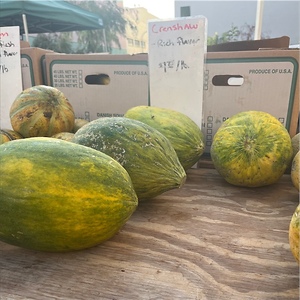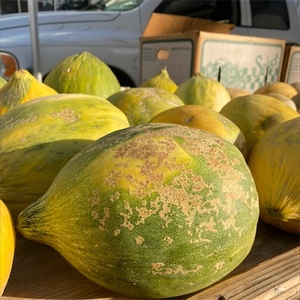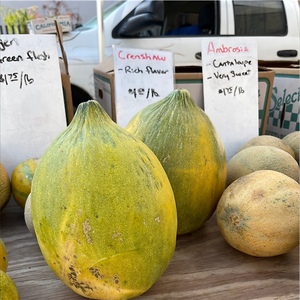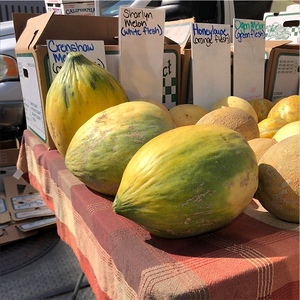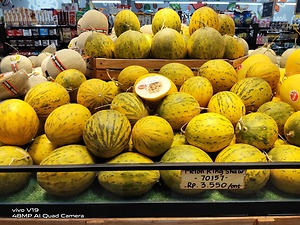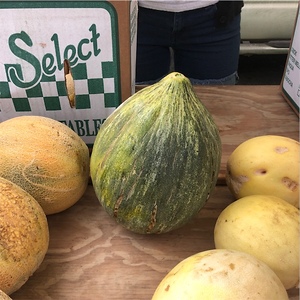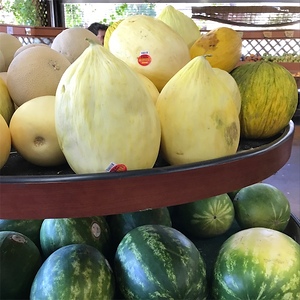


Crenshaw Melons
Estimated Inventory, 24 lb : 0
Description/Taste
Crenshaw melons are medium to large fruits, averaging 17 to 20 centimeters in diameter, and have an oblong to acorn shape with a flattened, broad base tapering towards a small point on the stem end. The rind is thick, hard, and ranges in color from yellow with green streaks to golden yellow. The rind also has a corrugated, waxy surface, giving the melon a textured, semi-rough feel. Underneath the rind, the light orange to peach flesh is dense, soft, succulent, and aqueous, encasing a central cavity filled with slippery light brown seeds and stringy white fibers. Crenshaw melons bear a sweet, vegetal, and floral aroma and should feel heavy for their size, generally averaging 8 to 10 pounds in weight. When ripe, the melons will give slightly when pressed on the stem end. The melons contain a mild, sweet, and floral flavor with subtle spice-forward nuances.
Seasons/Availability
Crenshaw melons are available in the mid-summer through the fall.
Current Facts
Crenshaw melons, botanically classified as Cucumis melo var. inodorous, are a sweet-fleshed variety belonging to the Cucurbitaceae family. The late-season melons generally take 110 to 120 days to mature, depending on the climate, and are highly favored for their soft, juicy flesh and mild, sweet flavor. Crenshaw melons are also known as Cranshaw melons and are a specialty cultivar commercially cultivated and grown in home gardens. There are two types of Crenshaw melons, specifically green and white varieties. Green Crenshaw melons are less common and are mainly reserved as a home garden cultivar. White Crenshaw melons are the most popular of the two and showcase improved growth characteristics such as being more resistant to sunburns. In commercial markets, both varieties may be generally labeled under the name Crenshaw to simplify the buying process, and there are also other specific varietal names such as Golden Crenshaw, Early Hybrid Crenshaw, Crane Crenshaw, Crenshaw Blanco, and Carnival.
Nutritional Value
Crenshaw melons are an excellent source of vitamin C to strengthen the immune system and reduce inflammation. The melons are also a good source of fiber to regulate the digestive tract, vitamin A to maintain healthy organ functioning, potassium to balance fluid levels within the body and contain lower amounts of iron, vitamin B6, and calcium. Beyond vitamins and minerals, Crenshaw melons contain a high water content and are also valued as a natural source of hydration.
Applications
Crenshaw melons have a mild, sweet flavor well suited for fresh and lightly cooked preparations. The fruits can be used similarly to cantaloupe in recipes and are primarily consumed fresh, served at room temperature. The rind and seeds are discarded before consumption, and once the flesh is sliced, it can be served on appetizer platters, in fruit bowls, tossed into green salads, or sprinkled with lime juice and salt as a tangy snack. Crenshaw melons can also be pureed into chilled soups, served as an edible garnish, wrapped in thinly sliced meat such as prosciutto, added into smoothies, or frozen and blended into sorbet. In addition to fresh preparations, Crenshaw melons are sturdy enough to stand up to light cooking and can be grilled for a savory-sweet flavor. The melons can also be grilled on skewers with mango and pineapple, seared in a hot pan to caramelize their natural sugar content, or harvested when still green and pickled for extended use. Crenshaw melons pair well with meats such as poultry, turkey, and pork, shrimp, fish, crab, and other seafood, almonds, herbs such as mint, basil, and parsley, coconut, and cucumbers. The hard rind of Crenshaw melons allows for extended shelf life. The melons will continue to ripen at room temperature and will keep for 1 to 3 weeks depending on ripeness and the climate it is stored in. Once cut, the melon pieces will keep 2 to 3 days when stored in a sealed container in the refrigerator.
Ethnic/Cultural Info
Crenshaw melons are a signature flavoring in a seasonal American IPA brewed by Banded Oak Brewing in Colorado. The Crenshaw Melon IPA is offered in limited quantities in three locations across the state, and the melons are grown locally at Hirakata Farms in Rocky Ford. The farm grows over 900 acres of melons and reserves several Crenshaw melons specifically for the beer collaboration. Craft breweries are teaming up with local farms to develop close relationships for business opportunities to showcase quality produce mixed with traditional brewing. Banded Oak Brewing has been in partnership with Hirakata Farms for six years to source quality Crenshaw melons. The melon varietal is favored for its sweet flavor and is combined into an IPA to create a refreshing, light, and flavorful seasonal beverage.
Geography/History
Crenshaw melons are believed by experts to be native to Turkey and are a cross between casaba and Persian melons. The exact history of the variety is unknown, but the cultivar was thought to have been first imported into America in the 20th century. There are also records of the melons being available through select American seed catalogs in 1929. Today Crenshaw melons are cultivated worldwide and are found in commercial markets and home gardens. The winter melon variety grows in temperate, warm, and desert regions and was selected for its late-ripening nature, sweet flavor, soft flesh, and extended storage capabilities. When in season, Crenshaw melons are sold through local markets, distributors, and select grocers. The variety is also sold through online seed catalogs for home garden cultivation.
Recipe Ideas
Recipes that include Crenshaw Melons. One



